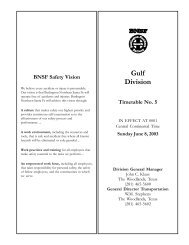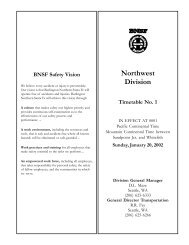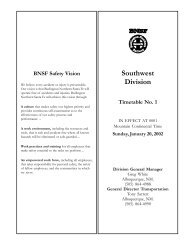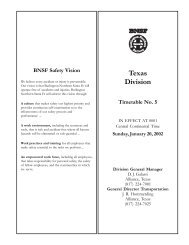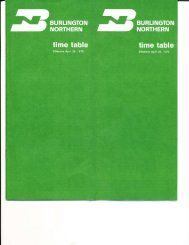2 11/5/03 - Friends of the Burlington Northern Railroad
2 11/5/03 - Friends of the Burlington Northern Railroad
2 11/5/03 - Friends of the Burlington Northern Railroad
Create successful ePaper yourself
Turn your PDF publications into a flip-book with our unique Google optimized e-Paper software.
NORTHWEST DIVISION—No. 2—November 5, 20<strong>03</strong>—New Westminster Subdivision<br />
41<br />
Locations Designated as Industrial Track<br />
Vancouver, BC Burrard Inlet Line (BI Line)—CN Railway<br />
operates jointly with BNSF on BI Line between Vancouver Yard<br />
and Waterfront. Movements on BI Line are controlled by CN<br />
Waterfront Traffic Coordinator, Lynn Creek, who must be<br />
contacted before entering or fouling <strong>the</strong> BI Line. These<br />
instructions do not modify <strong>the</strong> provisions <strong>of</strong> CROR Rule 105.<br />
Between Vancouver end <strong>of</strong> track and CN Jct.—CROR Rule<br />
105 applies.<br />
Between Tilbury Line Jct. (Townsend) MP 0.0 and Tilbury<br />
Island Dock MP 4.9—Train and engine movements on Tilbury<br />
Island Line will be made in accordance with CROR Rule 105.<br />
CN, CP and BNSF trains and engines switch on this line.<br />
Before leaving MP 3.5 (80th Street) on northward movements,<br />
contact BNSF RTC New Westminster, who will advise <strong>of</strong> any<br />
o<strong>the</strong>r movements being made on <strong>the</strong> line. This information does<br />
not modify provisions <strong>of</strong> CROR Rule 105.<br />
Rail Traffic Controllers—Territory between USA Canada<br />
Border MP <strong>11</strong>9.6 and end <strong>of</strong> track at Vancouver, B.C. is under<br />
jurisdiction <strong>of</strong> BNSF RTC at New Westminster.<br />
Vancouver Via Rail Coach Yard—Movements entering <strong>the</strong><br />
limits <strong>of</strong> <strong>the</strong> Vancouver Maintenance Centre (VMC) Coach Yard<br />
must obtain permission, ei<strong>the</strong>r by radio communication or<br />
personal contact, from <strong>the</strong> VIA Controller. When requesting<br />
permission to enter <strong>the</strong> limits <strong>of</strong> <strong>the</strong> VMC Coach Yard, <strong>the</strong><br />
movement identification and <strong>the</strong> route to be used must be<br />
communicated to <strong>the</strong> VIA Controller. Trains departing<br />
Vancouver Station must obtain permission from <strong>the</strong> VIA<br />
Controller before commencing movement.<br />
All movements must report clear when leaving <strong>the</strong> limits <strong>of</strong> <strong>the</strong><br />
VMC Coach Yard. The standby channel <strong>of</strong> <strong>the</strong> VIA Controller is<br />
AAR Channel 61. Stop signs in addition to Coach Yard limit<br />
signs have been placed at <strong>the</strong> entrance to <strong>the</strong> limits <strong>of</strong> <strong>the</strong> VMC<br />
Coach Yard.<br />
CN Jct.—Southward trains must obtain permission from RTC<br />
before passing north block signal at CN Jct. Trains and<br />
engines requiring use <strong>of</strong> <strong>the</strong> main track at CN Jct. for switching<br />
purposes must obtain permission from RTC before passing<br />
north block signal at CN Jct., and must report clear <strong>of</strong> main<br />
track when finished. After permission is received and switch is<br />
lined by hand for <strong>the</strong> intended route, movements will be<br />
governed by signal indication. Southward train or engine<br />
stopped by a Stop indication must not proceed until written<br />
authority has been received from RTC. Rule 509 is modified<br />
accordingly. Northward trains must advise RTC when clear <strong>of</strong><br />
<strong>the</strong> main track at CN Jct.<br />
Between CN Jct and Still Creek—The movement <strong>of</strong> trains<br />
and engines will be supervised by <strong>the</strong> RTC. Trains and<br />
engines must comply with RTC’s verbal and written<br />
instructions.<br />
Brownsville—Obtain permission from BNSF RTC New<br />
Westminster before fouling or entering controlled siding from<br />
auxiliary tracks. Notify BNSF RTC when clear <strong>of</strong> controlled<br />
siding on auxiliary tracks and switch properly lined for siding.<br />
Colebrook—CTC between MP 131.5 and MP 130.8 is under<br />
jurisdiction <strong>of</strong> BC Rail Port Subdivision RTC at North<br />
Vancouver, AAR Channel 39 (3939*1#), telephone (604) 984-<br />
5255.<br />
All train and engine movements must contact BC Rail RTC for<br />
permission to enter CTC territory controlled by BC Rail RTC,<br />
regardless <strong>of</strong> signal indication. When requesting such<br />
permission, each train or engine movement must advise BC<br />
Rail RTC if <strong>the</strong>y are handling dimensional shipment(s).<br />
Dimensional shipment(s) must not be set out or picked up in<br />
CTC territory controlled by BC Rail RTC unless permission to<br />
do so has been obtained from BC Rail RTC.<br />
TY&E personnel must use BC Rail CTC Authorization form,<br />
and Maintenance <strong>of</strong> Way personnel must use BC Rail Track<br />
Occupancy Permit (TOP) form, when obtaining authorities/<br />
permits on BNSF track controlled by BC Rail RTC, and on <strong>the</strong><br />
BC Rail Port Subdivision.<br />
Following are <strong>the</strong> identifiable locations which will be used on<br />
authorities/permits issued by <strong>the</strong> BC Rail RTC, along with <strong>the</strong><br />
corresponding BNSF designations:<br />
Signal Mile 131.5, North Controlled Block Signal North<br />
Colebrook<br />
Signal Mile 7.7, South Controlled Block Signal North Colebrook<br />
Signal Mile 7.0, North Controlled Block Signal South Colebrook<br />
Signal Mile 130.8, South Controlled Block Signal South<br />
Colebrook<br />
Signal Mile 7.8, BCR Controlled Block Signal governing<br />
eastward movement from BCR Roberts Bank Line to BNSF<br />
main track over BNSF dual control switch North Colebrook<br />
and BCR west dual control switch Mud Bay siding<br />
Signal Mile 6.9, BCR Controlled Block Signal governing<br />
westward movement from BCR Roberts Bank Line to BNSF<br />
main track over BNSF dual control switch South Colebrook<br />
North Junction Switch Colebrook, Dual control switch North<br />
Colebrook<br />
South Junction Switch Colebrook, Dual control switch South<br />
Colebrook<br />
In CTC territory controlled by BC Rail RTC, <strong>the</strong> provisions <strong>of</strong><br />
Rule 568(b) apply at an electrically locked hand operated<br />
switch, except that permission to enter or re-enter <strong>the</strong> main<br />
track need not be in writing for a train or engine authorized by<br />
CROR Rule 566 or CROR Rule 567.<br />
White Rock—Northward freight trains must report departure<br />
to RTC.<br />
Blaine—Northward passenger trains must report departure to<br />
RTC.<br />
Interlockings and Drawbridges Not Indicated at Station<br />
Fraser River Bridge, New Westminster—Locally controlled<br />
interlocking. CROR Rule 609 applies. All movements<br />
approaching bridge will use AAR Channel 61 to contact bridge<br />
signalman if necessary, and monitor this channel until clear <strong>of</strong><br />
<strong>the</strong> bridge.<br />
Trains, if tandem, must not exceed 100 cars and must not<br />
disconnect while any portion <strong>of</strong> <strong>the</strong> train is within interlocking<br />
limits. Engine bell must be rung continuously approaching and<br />
within interlocking limits.<br />
Swing span has been equipped with red warning signs at both<br />
ends. When in vertical position, <strong>the</strong>se signs indicate that <strong>the</strong><br />
span rail locks are disengaged and that movement must stop<br />
and be governed by fur<strong>the</strong>r instructions from <strong>the</strong> bridge<br />
signalman. When required to move over bridge by o<strong>the</strong>r than<br />
signal indication, movements approaching <strong>the</strong> span must be<br />
prepared to stop clear <strong>of</strong> a red sign between <strong>the</strong> rails at ei<strong>the</strong>r<br />
end <strong>of</strong> <strong>the</strong> span.<br />
Drawbridge 69—3.4 miles south <strong>of</strong> Colebrook. Manual<br />
interlocking. CROR Rule 608 applies. When interlocking signals<br />
display Stop indication, a member <strong>of</strong> <strong>the</strong> crew will immediately<br />
call RTC and be governed by his instructions.<br />
Maintenance <strong>of</strong> Way employees may occupy bridge between<br />
interlocking signals on verbal authority from bridge signalman,<br />
who must provide protection for movement until Maintenance<br />
<strong>of</strong> Way employee has reported clear <strong>of</strong> <strong>the</strong> limits.<br />
Trains passing Bridge 69 must have one radio in <strong>the</strong> controlling




